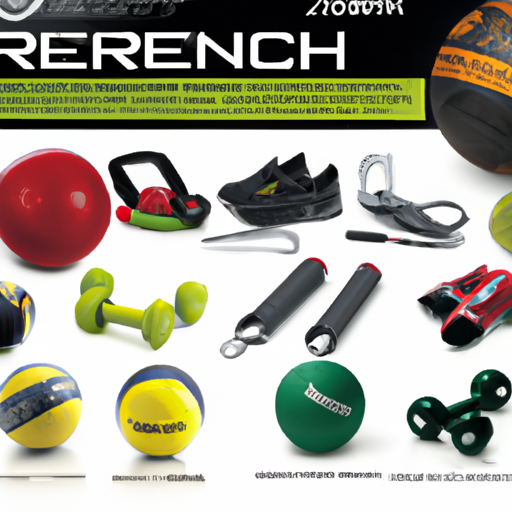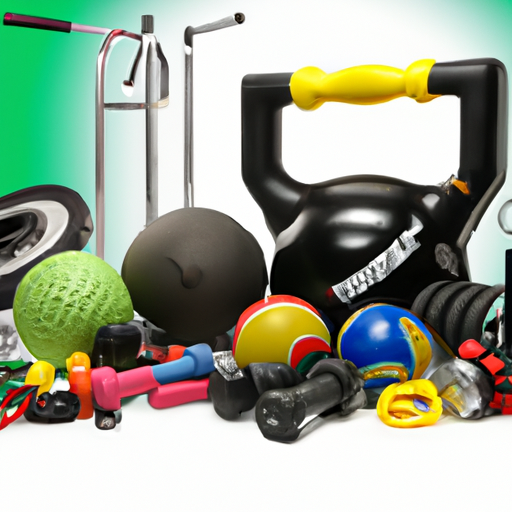When it comes to exercise, the traditional barbell and dumbbell exercises have long been go-to options for strength training. But have you ever wondered if there are alternatives to these classic exercises? Whether you’re looking for a change of pace or seeking options that are more accessible, there are indeed alternatives available to help you achieve your fitness goals. In this article, we will explore some creative and effective alternatives to traditional barbell and dumbbell exercises that can spice up your workout routine and keep you motivated on your fitness journey.

Why Consider Alternatives to Barbell and Dumbbell Exercises?
Benefits of Exploring Alternatives
When it comes to strength training and building muscle, barbell and dumbbell exercises have long been the go-to for many fitness enthusiasts. However, it’s important to also consider alternative exercise options that can provide unique benefits and help to keep your workouts interesting and challenging. Exploring alternative exercises not only adds variety to your routine, but it can also target different muscle groups, improve coordination and balance, and prevent overuse injuries. By incorporating alternative exercises into your fitness routine, you can maximize your results and take your workouts to the next level.
Common Limitations of Barbell and Dumbbell Exercises
While barbell and dumbbell exercises are effective in building strength and muscle mass, they do come with some limitations. One of the main limitations is the restricted range of motion. Traditional weightlifting exercises are usually performed in a linear and fixed plane of motion, which may not adequately mimic real-life movements. Additionally, if you’re lifting heavy weights, the risk of injury increases, especially if your form and technique are not properly executed. Another limitation is the lack of portability. Barbell and dumbbell workouts often require access to a gym or a dedicated home gym setup, which may not be convenient or accessible for everyone. Considering these limitations, it is worth exploring alternative exercise options to incorporate into your fitness routine.
Bodyweight Exercises
Benefits of Bodyweight Exercises
Bodyweight exercises are an excellent alternative to traditional barbell and dumbbell exercises as they offer a wide range of benefits. First and foremost, bodyweight exercises can be performed anywhere, anytime, without the need for any equipment. This makes them an ideal option for individuals who travel frequently or do not have access to a gym. Bodyweight exercises also promote functional strength, which means they help improve your ability to perform everyday activities with ease. The movements involved in bodyweight exercises often require multiple muscle groups to work together, improving coordination and overall athleticism. Additionally, bodyweight exercises can easily be modified to increase or decrease the intensity, making them appropriate for individuals of all fitness levels.
Different Types of Bodyweight Exercises
There are various types of bodyweight exercises that target different muscle groups and provide different challenges. Some popular bodyweight exercises include:
- Push-ups: These target the chest, shoulders, and triceps.
- Squats: These engage the muscles of the lower body, including the quadriceps, hamstrings, and glutes.
- Lunges: These target the legs, specifically the quadriceps and glutes.
- Plank: This exercise engages the core muscles, including the abdominals and lower back.
- Burpees: These are a full-body exercise that targets muscles all over the body while also providing a cardiovascular challenge.
Incorporating a variety of bodyweight exercises into your routine can help you engage different muscle groups and keep your workouts versatile and effective.

Resistance Bands
Advantages of Resistance Bands
Resistance bands are another fantastic alternative to traditional weightlifting equipment. They offer a unique form of resistance that challenges your muscles in a different way than barbells and dumbbells. One major advantage of resistance bands is their ability to provide variable resistance throughout the entire range of motion. This means that the resistance increases as you extend the band, providing a greater challenge to your muscles during the most difficult part of the exercise. Additionally, resistance bands are portable and lightweight, making them great for travel or at-home workouts.
Various Exercises Using Resistance Bands
Resistance bands can be used to target almost every muscle group in your body. Here are a few examples of exercises you can do with resistance bands:
- Banded Squats: Place the band around your thighs and perform squats. The band adds resistance to the movement, targeting your glutes and legs.
- Standing Rows: Attach the band to a stationary object, hold the handles, and step back to create tension. Pull the bands towards your body, targeting your back and arms.
- Banded Push-ups: Place the band around your back and hold the handles. Perform push-ups while maintaining tension on the band to challenge your chest, shoulders, and triceps.
- Hamstring Curl: Attach the band around your ankles and lie face down. Curl your legs towards your glutes, targeting your hamstrings.
- Side Lateral Raises: Step on the band with one foot and hold the handles. Raise your arms laterally to target your shoulders.
These are just a few examples of the many exercises you can perform with resistance bands. Incorporating them into your routine can add variety and challenge to your workouts.
Kettlebells
Benefits of Kettlebell Training
Kettlebells are a versatile and effective alternative to traditional barbell and dumbbell exercises. One major benefit of kettlebell training is its ability to combine strength training and cardiovascular conditioning into one workout. Kettlebell exercises often involve dynamic movements that engage multiple muscle groups while also increasing your heart rate. This makes kettlebell workouts efficient and effective for burning calories and improving overall fitness. Additionally, kettlebells provide an unstable load, which requires greater activation of the stabilizing muscles, promoting core strength and stability.
Popular Kettlebell Exercises
Here are some popular kettlebell exercises that you can incorporate into your workouts:
- Kettlebell Swings: This exercise targets the hips, glutes, and hamstrings, while also improving explosiveness and power.
- Goblet Squats: Holding a kettlebell by the handles, perform squats to target the legs and glutes.
- Turkish Get-Ups: This exercise challenges your balance and core strength while targeting the shoulders, hips, and glutes.
- Kettlebell Clean and Press: This movement targets the shoulders, upper back, and arms, while also engaging the lower body.
- Kettlebell Deadlifts: Similar to barbell deadlifts, this exercise targets the posterior chain, including the back, hamstrings, and glutes.
Incorporating kettlebell exercises into your routine can provide a refreshing challenge and help you reach your fitness goals.

Suspension Training
Benefits of Suspension Training
Suspension training, commonly known as TRX training, utilizes straps, handles, and your body weight to provide a challenging and effective workout. One major benefit of suspension training is its ability to engage your core muscles during every exercise. The instability provided by the suspension straps forces your core muscles to work harder to stabilize your body. Suspension training also allows you to easily adjust the level of difficulty by changing the angle or position of your body, making it suitable for individuals of all fitness levels. Furthermore, suspension training helps improve flexibility, balance, and joint stability.
Examples of Suspension-Based Exercises
Here are a few examples of exercises that can be performed using suspension training:
- TRX Rows: Holding the handles, lean back and perform rows by pulling your body towards the straps. This exercise targets your back and biceps.
- TRX Mountain Climbers: With your feet in the straps, assume a plank position and perform mountain climbers by bringing your knees towards your chest. This exercise targets the abs and shoulders.
- TRX Pistol Squat: Hold the handles and extend one leg forward while squatting with the other leg. This exercise challenges your leg strength, flexibility, and balance.
- TRX Chest Press: With your body facing away from the anchor point, hold the handles and perform a chest press by extending your arms forward. This exercise targets the chest, shoulders, and triceps.
- TRX Pike: Assume a push-up position with your feet in the straps. Keeping your legs straight, lift your hips up towards the ceiling, targeting the abs and shoulders.
Incorporating suspension training exercises into your workouts can add variety and intensity while improving your overall strength and stability.
Medicine Balls
Advantages of Medicine Balls
Medicine balls are weighted balls that come in various sizes and weights. They offer a unique alternative to traditional barbell and dumbbell exercises. One major advantage of medicine balls is their versatility. They can be used for a wide range of exercises, including throwing, catching, and slamming, making them suitable for both strength training and cardiovascular workouts. Medicine balls also provide an added challenge by requiring you to stabilize and control the weight, promoting functional strength and improving coordination. Additionally, medicine balls are safe and easy to use, making them suitable for individuals of all fitness levels.
Effective Medicine Ball Exercises
Here are some effective exercises you can perform using medicine balls:
- Medicine Ball Slams: Hold the medicine ball overhead and forcefully slam it down to the ground. This exercise targets the abs, shoulders, and arms.
- Russian Twists: Sit on the ground with your knees bent and hold the medicine ball in front of your chest. Rotate your torso from side to side, targeting your obliques.
- Medicine Ball Squat to Press: Hold the medicine ball at your chest, squat down, and explosively stand up while pressing the ball overhead. This exercise targets the legs, shoulders, and arms.
- Medicine Ball Woodchoppers: Stand with your feet shoulder-width apart and hold the medicine ball with both hands on one side of your body. Swing the ball diagonally across your body, engaging your core and obliques.
- Medicine Ball Wall Throws: Stand facing a wall with the medicine ball at your chest. Throw the ball forcefully against the wall and catch it as it bounces back. This exercise targets the chest, shoulders, and arms.
Incorporating medicine ball exercises into your routine can add variety and challenge to your workouts while strengthening multiple muscle groups.

Sandbags
Benefits of Sandbag Training
Sandbag training is a unique and effective alternative to traditional weightlifting exercises. One major benefit of sandbag training is its ability to mimic real-life movements and improve functional strength. Sandbags provide an unstable and shifting load, forcing your muscles to work harder to stabilize and control the weight. This promotes overall body strength and stability, which is essential for everyday activities. Additionally, sandbags are versatile and can be used for a wide range of exercises, making them suitable for both beginners and advanced fitness enthusiasts.
Sandbag Exercises for Strength and Endurance
Here are a few examples of sandbag exercises you can incorporate into your workouts:
- Overhead Sandbag Press: Hold the sandbag at your chest, squat down, and explosively stand up while pressing the sandbag overhead. This exercises targets the shoulders, legs, and core.
- Sandbag Zercher Squats: Hold the sandbag in the crooks of your elbows and perform squats. This exercise targets the lower body, specifically the quadriceps and glutes.
- Sandbag Clean and Press: Lift the sandbag from the ground and bring it to your shoulders. From there, press the sandbag overhead. This exercise targets the upper body and core.
- Sandbag Burpees: Hold the sandbag at your chest while performing burpees. This adds resistance and challenges your entire body.
- Sandbag Lunges: Place the sandbag on your shoulders and perform lunges forward, targeting your legs and glutes.
Incorporating sandbag training exercises into your routine can help improve your overall strength, stability, and endurance.
Battle Ropes
Benefits of Battle Rope Workouts
Battle ropes provide a challenging and dynamic alternative to traditional barbell and dumbbell exercises. One major benefit of battle rope workouts is their ability to provide a full-body workout in a short amount of time. The rhythmic waves and slams of the battle ropes engage your upper body, lower body, and core muscles simultaneously, resulting in a high-intensity workout that improves cardiovascular endurance and muscular strength. Battle rope workouts also help improve grip strength and coordination while reducing the strain on the joints.
Types of Battle Rope Exercises
Here are a few examples of battle rope exercises you can incorporate into your workouts:
- Alternating Waves: Stand with your feet shoulder-width apart and hold one end of the battle ropes in each hand. Rapidly alternate raising and lowering each arm, creating waves throughout the ropes. This exercise engages your entire upper body and core.
- Slam Waves: Stand with your feet shoulder-width apart and hold one end of the battle ropes in each hand. Explosively lift both arms overhead and then slam the ropes down to the ground. This exercise targets your upper body, core, and legs.
- Circles: Stand with your feet shoulder-width apart and hold one end of the battle ropes in each hand. Keeping your arms straight, move them in a circular motion, creating circles with the ropes. This exercise engages your shoulders, arms, and core.
- Side-to-Side Waves: Stand with your feet shoulder-width apart and hold one end of the battle ropes in each hand. Move your arms from side to side, creating waves that travel horizontally along the ropes. This exercise targets your shoulders, arms, and core.
- Battle Rope Burpees: Start with the battle ropes laid out on the ground. Perform a burpee by jumping down, kicking your feet back, returning to the standing position, and then slam the ropes down as you jump up. This exercise provides a full-body challenge.
Incorporating battle rope exercises into your routine can add intensity, challenge, and variety to your workouts while improving your overall strength and endurance.
Functional Training
Introduction to Functional Training
Functional training focuses on improving your ability to perform everyday activities with ease and efficiency. It is a functional approach to fitness that emphasizes movements that mimic real-life actions, thereby improving overall strength, flexibility, and balance. Functional training exercises target multiple muscle groups, improve coordination and stability, and help prevent injuries. By incorporating functional training into your routine, you can enhance your performance in sports and daily activities, as well as improve your overall fitness and well-being.
Functional Exercises for Everyday Activities
Here are a few examples of functional exercises that you can incorporate into your workouts:
- Squats: Squats mimic the movement patterns involved in sitting and standing up, making them functional for everyday activities.
- Deadlifts: Deadlifts improve your ability to safely lift heavy objects off the ground, which is a common movement in everyday life.
- Step-ups: Step-ups simulate the actions of climbing stairs and are beneficial for improving lower body strength and stability.
- Lunges: Lunges replicate the movement patterns involved in walking and running, making them functional for lower body strength and stability.
- Single-leg Balance Exercises: Balancing on one leg, such as in yoga tree pose, helps improve stability and coordination, which are essential for everyday activities like walking and standing.
Incorporating functional exercises into your routine can improve your overall fitness and help you perform everyday activities with greater ease and efficiency.
Conclusion
While traditional barbell and dumbbell exercises have their place in strength training, it’s important to explore alternatives to keep your workouts interesting and effective. Bodyweight exercises, resistance bands, kettlebells, suspension training, medicine balls, sandbags, battle ropes, and functional training all offer unique benefits that can enhance your strength, endurance, coordination, and overall fitness. By incorporating a variety of exercises and equipment into your routine, you can maximize your results and enjoy a well-rounded and engaging workout experience. So, why limit yourself when there are so many exciting alternatives waiting to be explored? Start incorporating these alternatives into your fitness routine today and discover a whole new world of possibilities.
